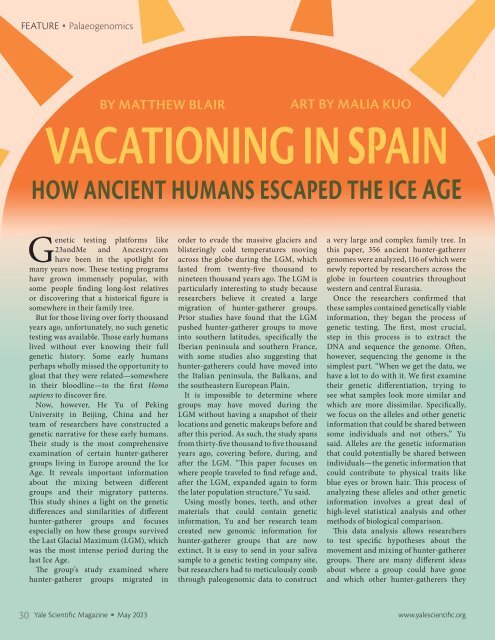YSM Issue 96.2
Create successful ePaper yourself
Turn your PDF publications into a flip-book with our unique Google optimized e-Paper software.
FEATURE<br />
Palaeogenomics<br />
BY MATTHEW BLAIR<br />
ART BY MALIA KUO<br />
VACATIONING IN SPAIN<br />
HOW ANCIENT HUMANS ESCAPED THE ICE AGE<br />
Genetic testing platforms like<br />
23andMe and Ancestry.com<br />
have been in the spotlight for<br />
many years now. These testing programs<br />
have grown immensely popular, with<br />
some people finding long-lost relatives<br />
or discovering that a historical figure is<br />
somewhere in their family tree.<br />
But for those living over forty thousand<br />
years ago, unfortunately, no such genetic<br />
testing was available. Those early humans<br />
lived without ever knowing their full<br />
genetic history. Some early humans<br />
perhaps wholly missed the opportunity to<br />
gloat that they were related—somewhere<br />
in their bloodline—to the first Homo<br />
sapiens to discover fire.<br />
Now, however, He Yu of Peking<br />
University in Beijing, China and her<br />
team of researchers have constructed a<br />
genetic narrative for these early humans.<br />
Their study is the most comprehensive<br />
examination of certain hunter-gatherer<br />
groups living in Europe around the Ice<br />
Age. It reveals important information<br />
about the mixing between different<br />
groups and their migratory patterns.<br />
This study shines a light on the genetic<br />
differences and similarities of different<br />
hunter-gatherer groups and focuses<br />
especially on how these groups survived<br />
the Last Glacial Maximum (LGM), which<br />
was the most intense period during the<br />
last Ice Age.<br />
The group’s study examined where<br />
hunter-gatherer groups migrated in<br />
order to evade the massive glaciers and<br />
blisteringly cold temperatures moving<br />
across the globe during the LGM, which<br />
lasted from twenty-five thousand to<br />
nineteen thousand years ago. The LGM is<br />
particularly interesting to study because<br />
researchers believe it created a large<br />
migration of hunter-gatherer groups.<br />
Prior studies have found that the LGM<br />
pushed hunter-gatherer groups to move<br />
into southern latitudes, specifically the<br />
Iberian peninsula and southern France,<br />
with some studies also suggesting that<br />
hunter-gatherers could have moved into<br />
the Italian peninsula, the Balkans, and<br />
the southeastern European Plain.<br />
It is impossible to determine where<br />
groups may have moved during the<br />
LGM without having a snapshot of their<br />
locations and genetic makeups before and<br />
after this period. As such, the study spans<br />
from thirty-five thousand to five thousand<br />
years ago, covering before, during, and<br />
after the LGM. “This paper focuses on<br />
where people traveled to find refuge and,<br />
after the LGM, expanded again to form<br />
the later population structure,” Yu said.<br />
Using mostly bones, teeth, and other<br />
materials that could contain genetic<br />
information, Yu and her research team<br />
created new genomic information for<br />
hunter-gatherer groups that are now<br />
extinct. It is easy to send in your saliva<br />
sample to a genetic testing company site,<br />
but researchers had to meticulously comb<br />
through paleogenomic data to construct<br />
a very large and complex family tree. In<br />
this paper, 356 ancient hunter-gatherer<br />
genomes were analyzed, 116 of which were<br />
newly reported by researchers across the<br />
globe in fourteen countries throughout<br />
western and central Eurasia.<br />
Once the researchers confirmed that<br />
these samples contained genetically viable<br />
information, they began the process of<br />
genetic testing. The first, most crucial,<br />
step in this process is to extract the<br />
DNA and sequence the genome. Often,<br />
however, sequencing the genome is the<br />
simplest part. “When we get the data, we<br />
have a lot to do with it. We first examine<br />
their genetic differentiation, trying to<br />
see what samples look more similar and<br />
which are more dissimilar. Specifically,<br />
we focus on the alleles and other genetic<br />
information that could be shared between<br />
some individuals and not others,” Yu<br />
said. Alleles are the genetic information<br />
that could potentially be shared between<br />
individuals—the genetic information that<br />
could contribute to physical traits like<br />
blue eyes or brown hair. This process of<br />
analyzing these alleles and other genetic<br />
information involves a great deal of<br />
high-level statistical analysis and other<br />
methods of biological comparison.<br />
This data analysis allows researchers<br />
to test specific hypotheses about the<br />
movement and mixing of hunter-gatherer<br />
groups. There are many different ideas<br />
about where a group could have gone<br />
and which other hunter-gatherers they<br />
30 Yale Scientific Magazine May 2023 www.yalescientific.org

















